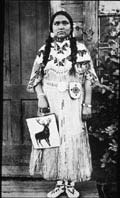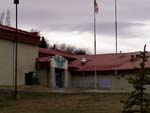As a student now entering this module, regardless of whether you are a Schitsu'umsh or suyepmsh (a white person; non-Indian), a younger person or elder, it is our sincere desire that you learn as much as you possibly can about our culture and history, and do so from a Schitsu'umsh perspective. We hope that you will better appreciate and view the world as if through Schitsu'umsh eyes.
|
|
Listen as Cliff SiJohn considers the many ways of teaching, the importance of distinguishing "head" knowledge from "heart" knowledge, and the need to speak with both the mind and the heart. Cliff asks that you place yourself as if a child, sitting before your grandfather and listening . . . . . Part 8 of Interview; To begin the SiJohn Interview. (interviewed and edited by Rodney Frey, August 2002) |
 | | Rosie Wildshoe, ca. 1910 |
To help you accomplish this challenging, and for some perhaps ultimately elusive goal, we ask that before you take a look at us you take a closer look at yourself. Become aware of the particular "skills and abilities" you bring with you as you enter this module, and then consider adding a few more "tricks" to your inventory. Inevitably, what you bring with you as you travel the landscape of this module will either allow you to stay on the trails established by the First Peoples, or cause you to stray from those trails.
You will soon be introduced to Smiyiw (Coyote), who always has something to teach us. As you will discover, Coyote has a rather unusual, albeit creative, assemblage of skills and abilities with which he relies upon in order to obtain his desires. Typically, when he applies these particular methods in the service of his family and to help out others, he likely succeeds in his endeavors. But when Coyote applies those very same methods against his family, for his own self ends, he likely fails and is made a "fool." Certain tricks only work in certain situations.
|
|
Cliff SiJohn continues discussing the importance of speaking from the mind and the heart, and the role of the teacher. Cliff asks, "how do you measure the success of a person?" |
In attempting to learn about and appreciate another cultural tradition, to see from a Schitsu'umsh perspective, "how" one accesses and learns about that culture is as important as "what" materials are actually presented about that culture. The "how" - the skills and methods, the pedagogy - is intrinsically related to the "what" - the content and subject materials. For some of you the world of the Schitsu'umsh will be a new and very curious experience. You may discover that the way we relate to animals and plants and to other humans, and even the way we view such things as "time" and "space" and "causation" differs considerably from how you view these things. And it follows that our teaching methods, our pedagogy, the way we pass on that culture, would also be very different from the methods you use to learn about your own culture. Round pegs so nicely fit round holes.
 | | Coeur d'Alene Tribal School |
We simply ask that you be aware of your "methods." When Euro-American methods, "skills and abilities," are blindly applied to learn about Indian culture, those methods so typically render only a Euro-American gloss of Indian culture. What is thought to be Indian is ultimately only Euro-Americanized. Don't be a foolish Coyote! But when learning methods more akin to an Indian world view are relied upon, the world of the Schitsu'umsh can be more easily traveled as it is meant to be.
To add to your inventory of skills and abilities as you approach the world of the Schitsu'umsh, we would have you consider the following methods. These pedagogical suggestions are listed in the < - - - left hand column. Regardless of whether you are a Suyepmsh or a Schitsu'umsh, keep in mind the goal for this module - to better appreciate and view the world through Schitsu'umsh eyes - to understand
hnkhwelkhwlnet, "our ways of life in the world."
© Coeur d'Alene Tribe 2002
< previous | next > |




